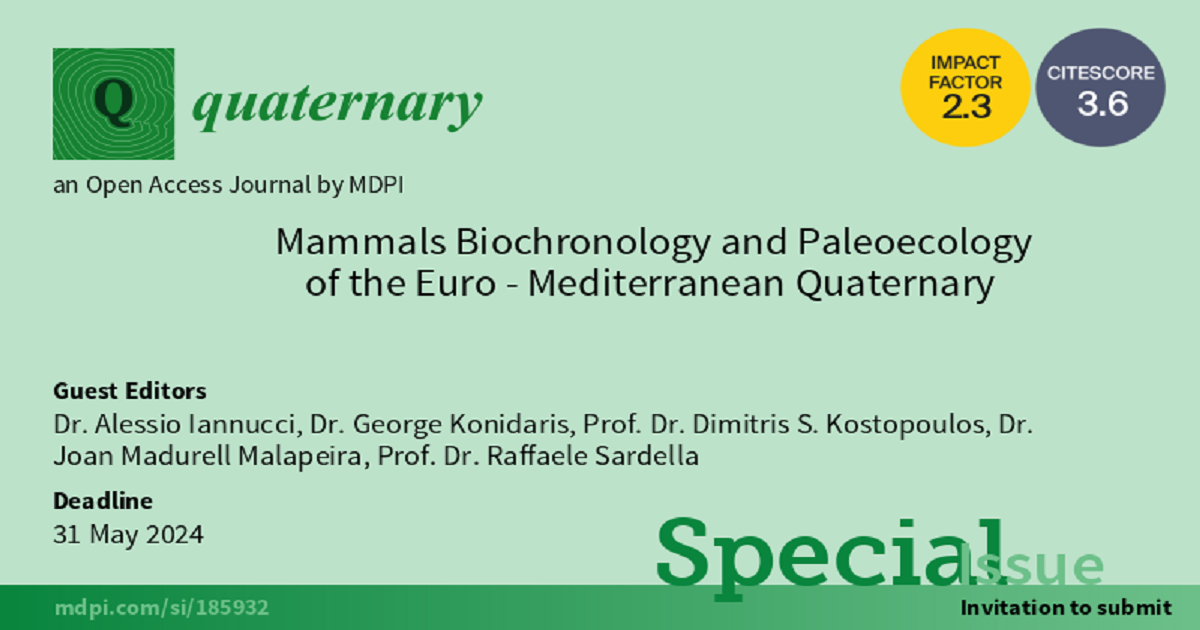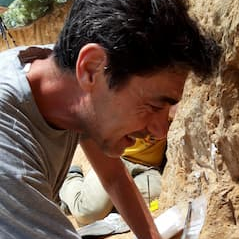Mammals Biochronology and Paleoecology of the Euro-Mediterranean Quaternary
A special issue of Quaternary (ISSN 2571-550X).
Deadline for manuscript submissions: 31 May 2024 | Viewed by 5268

Special Issue Editors
Interests: paleontology; paleobiology; paleoecology; paleobiogeography; biochronology; ecomorphology; faunal turnover; taxonomy; zoological nomenclature; mammals
Interests: neogene and quaternary vertebrate faunas; taxonomy and evolution; biochronology and biostratigraphy; taphonomy; palaeobiogeography; palaeoecology; proboscidea evolution; megafauna-homo interactions; carnivoran guilds
Interests: mammal palaeontology; artiodactyla; neogene; quaternary; systematics; phylogeny; palaeoecology
2. Department of Geology, Autonomous University of Barcelona, Cerdanyola del Vallès, 08193 Barcelona, Spain
Interests: vertebrate paleontology; neuroanatomy; stable isotopes; paleoecology; mammals; taxonomy; systematics; ecology and evolution; biodiversity; phylogenetic analysis; conservation ecology
Special Issue Information
Dear Colleagues,
The Quaternary is a time of fundamental climatic shifts and environmental changes that highlight the need for a thorough investigation from different perspectives and at multiple scales to disentangle the factors involved in the response of the biota. In turn, recognizing bioevents (e.g., the dispersal or extinction of species) and relating them to geological time is crucial for correlating changes between distant geographic regions. The mammalian fossil record is widely used for biochronological correlations and palaeoecological reconstructions of the Euro-Mediterranean region and represents an especially important proxy for inferring the timing, pattern, and paleoenvironmental context of the earliest events of hominin dispersal into Europe. Conducting research on the response of mammals to the paleoenvironmental changes of the Euro-Mediterranean Quaternary and developing a consistent and precise pan-European biochronological framework both require the thoughtful integration of data and schemes from different geographic areas. This is especially relevant considering the wealth of new discoveries made in the last few decades and the semantic and conceptual differences in the use of biochronological terms like Mammal Ages (e.g., Villafranchian and Galerian).
This Special Issue will aim to gather contributions derived from the homonymous session organized at the XXI INQUA conference (Rome, July 14th–20th 2023), featuring research on the evolution of mammal communities and ecosystems and the identification and definition of bioevents, including taxonomic studies, and the discussion of their broader biochronological and palaeoecological significance.
Dr. Alessio Iannucci
Dr. George Konidaris
Prof. Dr. Dimitris S. Kostopoulos
Dr. Joan Madurell Malapeira
Prof. Dr. Raffaele Sardella
Guest Editors
Manuscript Submission Information
Manuscripts should be submitted online at www.mdpi.com by registering and logging in to this website. Once you are registered, click here to go to the submission form. Manuscripts can be submitted until the deadline. All submissions that pass pre-check are peer-reviewed. Accepted papers will be published continuously in the journal (as soon as accepted) and will be listed together on the special issue website. Research articles, review articles as well as short communications are invited. For planned papers, a title and short abstract (about 100 words) can be sent to the Editorial Office for announcement on this website.
Submitted manuscripts should not have been published previously, nor be under consideration for publication elsewhere (except conference proceedings papers). All manuscripts are thoroughly refereed through a single-blind peer-review process. A guide for authors and other relevant information for submission of manuscripts is available on the Instructions for Authors page. Quaternary is an international peer-reviewed open access quarterly journal published by MDPI.
Please visit the Instructions for Authors page before submitting a manuscript. The Article Processing Charge (APC) for publication in this open access journal is 1600 CHF (Swiss Francs). Submitted papers should be well formatted and use good English. Authors may use MDPI's English editing service prior to publication or during author revisions.
Keywords
- biochronology
- bioevent
- paleoecology
- paleobiogeography
- dispersal
- faunal correlation
- faunal turnover
- mammals
- Europe
- Mediterranean
- Pleistocene
- quaternary
Planned Papers
The below list represents only planned manuscripts. Some of these manuscripts have not been received by the Editorial Office yet. Papers submitted to MDPI journals are subject to peer-review.
Title: The Gelasian carnivoran palaeoguild of Coste San Giacomo (Anagni, central Italy): biochronological implications
Authors: Bellucci L.; Bona F., Conti J., Iurino D.A., Mecozzi B., Strani F., Sardella R.
Affiliation: Museo di Geologia e Paleontologia, Università di Firenze
Title: Middle Pleistocene hippopotamuses from the Italian Peninsula: an overview
Authors: Mecozzi B.; Iannucci A.; Arzarello M.; Carpentieri M.; Moncel M.-H.; Peretto C.; Sala B.; Sardella R.
Affiliation: Sapienza University of Rome
Title: The Early Pleistocene large mammal succession of Greece: implications for pan-European biogeographic correlations
Authors: Kostopoulos D.; Konidaris G.
Affiliation: School of Geology, Aristotle University of Thessaloniki
Title: The late Early–Middle Pleistocene mammal fauna from the Megalopolis Basin (Peloponnese, Greece) and its importance for biostratigraphy and palaeoenvironment
Authors: Konidaris G., Athanassiou A., van Kolfschoten T., Tourloukis V., Panagopoulou E., Karkanas P., Harvati K.
Affiliation: Palaeoanthropology, Eberhard Karls University of Tübingen
Title: The Occurrence of Suids in the Post-Olduvai to Pre-Jaramillo Pleistocene of Europe and Implications for Late Villafranchian Biochronology and Faunal Dynamics
Authors: Alessio Iannucci
Affiliation: Eberhard-Karls-University Tübingen
Abstract: It has been proposed that suids were absent from Europe during the post-Olduvai to pre-Jaramillo Early Pleistocene (from less than 1.8 to more than 1.2 Ma) and that their “re-appearance” in the late Early Pleistocene would mark the end of the late Villafranchian and the beginning of the Epivillafranchian. Arguments enumerated in favor of this “suid gap” are the lack of suid remains from extensively sampled fossil localities of this age and the high reproductive potential (r- strategy) of suids, which would translate in a high commonness of their remains in the fossil record. However, here it shown that, while suids reproductive potential is certainly exceptional within artiodactyls, there is no direct relationship between reproductive strategy and preservation rate of a taxon in the fossil record. In Early Pleistocene localities of Europe and adjoining areas, where suids are present in a fossil assemblage they are always rare. In terms of number of oc-currences (frequency), suids range from being moderately common (~2.0-1.8 Ma) to moderately rare (~1.1-1.0 Ma). Suid material is also described herein from Peyrolles (Issoire, France; reference locality for MNQ 19), a site dated at 1.47 Ma, providing direct evidence for the presence of suids within the purported “suid gap”. The case of suids underlines an important source of caveat in inferring faunal dynamics of the late Early Pleistocene of western Europe —including the dis-persal of hominins— i.e., the unequal geographical distribution of the paleontological sites of post-Olduvai to pre-Jaramillo age. Indeed, Peyrolles is the only large mammal site in western Europe located outside the Iberian and Italian Peninsulas reliably dated around 1.5 Ma. In the post-Olduvai to pre-Jaramillo period, there is a paucity of radiometric estimates (or they have a too coarse resolution) and of paleomagnetic excursions detectable in continental deposits. Basi-cally, for this time span there is a high dependance on biochronological correlations while at the same time these correlations are less reliable —because based on a few sites not covering the en-tire spectrum of environments present in Europe and not dated independently with methods that outperform biochronology— than for other periods.
Title: Attractiveness of the Denizli Basin for humans and animals during the Early Pleistocene (1.6-1.2 Ma). A pathway to Europe through Anatolia?
Authors: Boulbes N.; Moigne A.-M.; Mayda S.; Titov V.; Falguères C.; Tombret O.; Bahain J.-J.; Lebatard A.-E.; Vialet A.; Alçiçek M.C.
Affiliation: Institut de Paléontologie Humaine, Fondation Albert Ier, Paris









